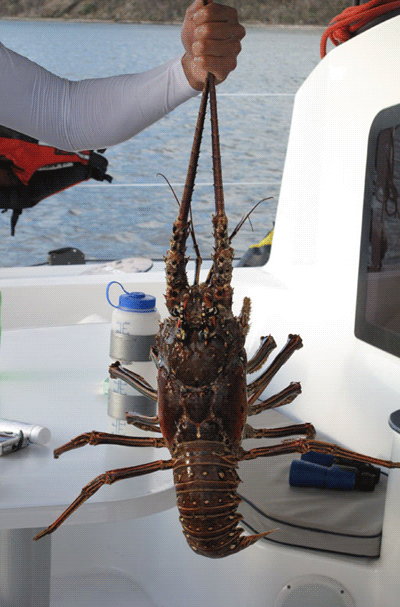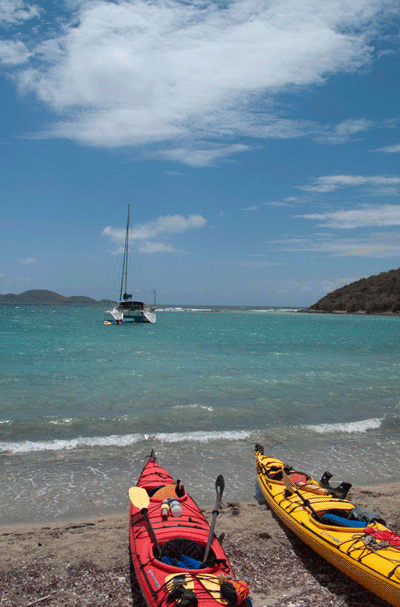From April 21-27, 2018 we will be running another kayak tour of the “Spanish Virgin Islands”: the islands of Culebra, Vieques and the many smaller surrounding cays. This will be a yacht-supported tour, where you will kayak and snorkel during the day, but sleep on board a large catamaran at night. Most of our meals will be served on board this “mothership.” There are only eight spaces available for this trip, in four cabins on the catamaran. Because space on this trip is extremely limited, we suggest you call us early to reserve. Below is a detailed description of our trip from several years ago.
Spanish Virgin Islands Tour
by Arthur Jones, captain and guide
Day 1: Our first guests, Ann and Arthur (having another Arthur on this trip makes it somewhat confusing at times), arrive at the CYOA dock in Frenchtown, St. Thomas, in the mid-afternoon while we are getting the boat ready. It turns out they have been on an Arawak trip once before – on our Anegada trip, although we’ve never met. I introduce myself, and also introduce the rest of the crew: Joseph, who is our kayaking guide, and my 10 year old son Evan, who is playing hooky this week from school so he can be my first mate. The guests store their bags in their berths and then we all go for a “shakedown” cruise in the harbor. The boat is named “Clarity” and she’s a 40 foot Fountaine Pajot catamaran, with 4 berths and 2 heads. There’s also a “cozy cabin” in front of the forward berth, which is the perfect size for a 10 year old boy. One of the guests has quite a bit of sailing experience, which is welcome because I’m still getting used to sailing this big cat, although I’ve got plenty of mono hull experience. We pass our check-out from the charter company, then pick up a mooring in the harbor. While the guests relax on board, the crew goes ashore for some last-minute provisions, and to meet Mike, our final guest. Mike has also been on an Arawak trip before – in fact, he’s been on three Arawak trips: our BVI trip, our Anegada trip and our Epic trip! We catch up with the others and have a fabulous dinner that night at “Epernay,” a quaint bistro in Frenchtown.
Day 2: We wake early and set sail with the trade winds to the town of Dewey, on Culebra. It’s a fairly easy and relaxing sail, with some rolling swells behind us. We pick up a mooring at Dakity Harbor, at the mouth of Ensenada Honda. We then launch the kayaks and Joseph takes the kayakers into Dewey, while Evan and I follow in the dinghy. We pull the kayaks ashore and wander around this funky little town, searching for the customs office. We barely make it to customs before they close, then grab a cold beer and try some of the local black bean cakes at a roadside bar. From here, it’s an easy, lazy downwind paddle back to the boat for a delicious dinner of grilled tuna, with mashed potatoes and asparagus.

Launching the kayaks at Dakity Harbor. Photo courtesy of Arthur Marshall
Day 3: After breakfast, the kayakers set off for Cayo Luis Pena, an uninhabited cay to the west of Culebra. Evan and I take this opportunity to grab our fly rods and fish for an hour or so before driving the catamaran around to meet the paddlers for lunch. After lunch, we head on to Pta Tamarindo, on the northern tip of Culebra. It’s a beautiful protected cove, and we all put on our snorkel gear to check out the underwater scene. It’s here that we find “Leroy”: the nine and a half pound lobster that we’ll feast upon for the next day and a half.

“Leroy,” our mascot. photo by Arthur Marshall Day.
Day 4: We set off from Pointa Tamarindo towards Flamenco Beach. The paddling is calm in the protected waters along the western side of the peninsula, and the kayakers stop on an isolated beach where there are gun turrets, left over from the days when the US Navy held training exercises here. Once we round the northwest point and are exposed to the Atlantic, the paddling becomes much more difficult. Big swells crash on the rocks nearby, and progress is slow against the stiff headwind. We inch our way up the coastline until we reach the sheltered waters of Flamenco Bay. It’s a gorgeous white sand beach and the snorkeling here is fabulous! We have lunch aboard the catamaran (lobster salad!), then decide it’s best to sail from here to Isla Culebrita, rather than battling the headwind. We pull into the harbor on the north side of Culebrita in the late afternoon and are pleased to discover no other boats in the bay. We anchor, then go ashore for a hike up to the abandoned lighthouse which was built by the Spanish in the late 1800’s. The ruins of the lighthouse are spectacular, and the views from the tower are awesome.
As we watch the sunset from the lighthouse, someone notices a waterspout in the distance. We can clearly see it’s long tail extending from the clouds and touching the surface of the water and we are thankful that we are safely watching it from this vantage point, rather than being out on the water. As we hike back to the beach while the sun is fading on the horizon, we see a deer crossing a dried-up salt pond, and we wonder how he made it out here to this uninhabited cay.
Day 5: I wake shortly after dawn and peer out the cabin window to see about a dozen deer on the beach. I wake Evan so he can see it too, and we watch as the deer run up and down along the beach, kicking up their heels and having a great time. Evan wants to go ashore for a closer look, so he and a few of the others get in the dinghy while I start preparing breakfast. We decide over breakfast that it might be wise to sail to Vieques, rather than a long open water crossing. That way, we’ll have more time to explore the shoreline. It turns out to be an easy sail – a beam reach the whole way to the eastern tip of Vieques. We round the rocky point and spot a secluded anchorage on the south side. We head in so we can have lunch and launch the kayaks and we’re about to anchor when someone hails us on the VHF. It turn out it’s the US Navy and we have inadvertently entered a restricted area. Although the Navy discontinued is bombing exercises on the island a few years ago, they are still cleaning up unexploded ordinances and are about to begin “demolitions.” We are instructed to continue on to another anchorage – any of the anchorages to the west of the guard tower high atop the island. We decide on Ensenada Honda, a few miles to our west. It’s a deep, protected anchorage lined with mangroves that is a famous hurricane hole for local boaters. We anchor and launch the kayaks and while the rest of the group explores the mangroves, Evan and I grab our fly rods so we can search for bonefish.
From our anchorage at Ensenada Honda, we can see smoke from the Navy’s “demolitions.” Photo by Arthur Marshall.
Day 6: The guests announce that they want a long day of paddling, so they get an early start and head downwind, exploring each cove between Ensenada Honda and Mosquito Bay. We decide we’ll rendezvous in the late afternoon at the entrance to the bioluminescent bay. Evan and I fish most of the morning and then bring the catamaran around to meet up with the rest of the group. We go for a late afternoon snorkel to look for more lobster – Evan is obsessed about catching his own.

Evan managed to catch a lobster, but it turned out to be the size of a shrimp cocktail! (it was released). Photo by Arthur Marshall.
After dinner, we set out for a night-time paddle around the bay. The phosphoresence here is truly amazing – nothing short of psychedelic! The best part of this night paddle is the swim – the experience is like bathing in the stars!
Day 7: We set out early for an all-day sail back to St Thomas. We tack back and forth, making our way slowly up the south shore of Vieques. After about three hours of tacking and making little upwind progress, we decide to motor-sail. We fire up the engines and set a course for the western end of St. Thomas. A squall hits us just before we reach St. Thomas, and then the seas turn perfectly calm and glassy, so we take down the sails and motor up the coastline, arriving at the fuel dock in Crown Bay around 4:00 pm. We have to get fuel before we return the boat, but it’s been a long sail, and the guests are ready to get off the boat, so they grab their gear and we say our goodbyes. It’s been a great trip – one of the best I’ve been on in over 15 years of guiding these trips. I can’t wait til next year.
- length of trip: 7 days
- accommodations: berth aboard large catamaran
- included: most meals (meals ashore are not included), all equipment, kayaks, paddles, PFDs, etc.
- departs from: St. Thomas, USVI
- price: $2495/person
- dates of tour: April 21-27, 2018


